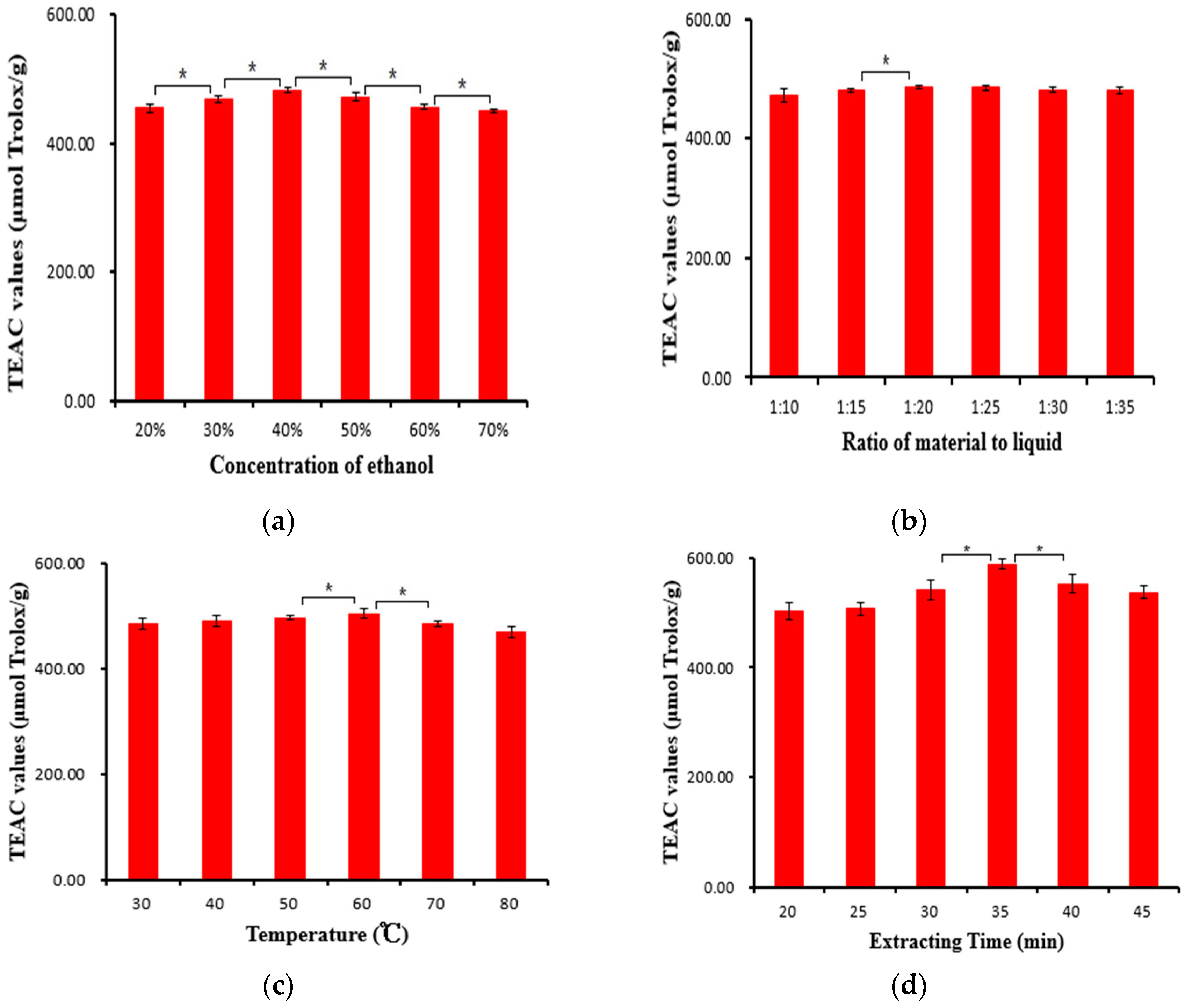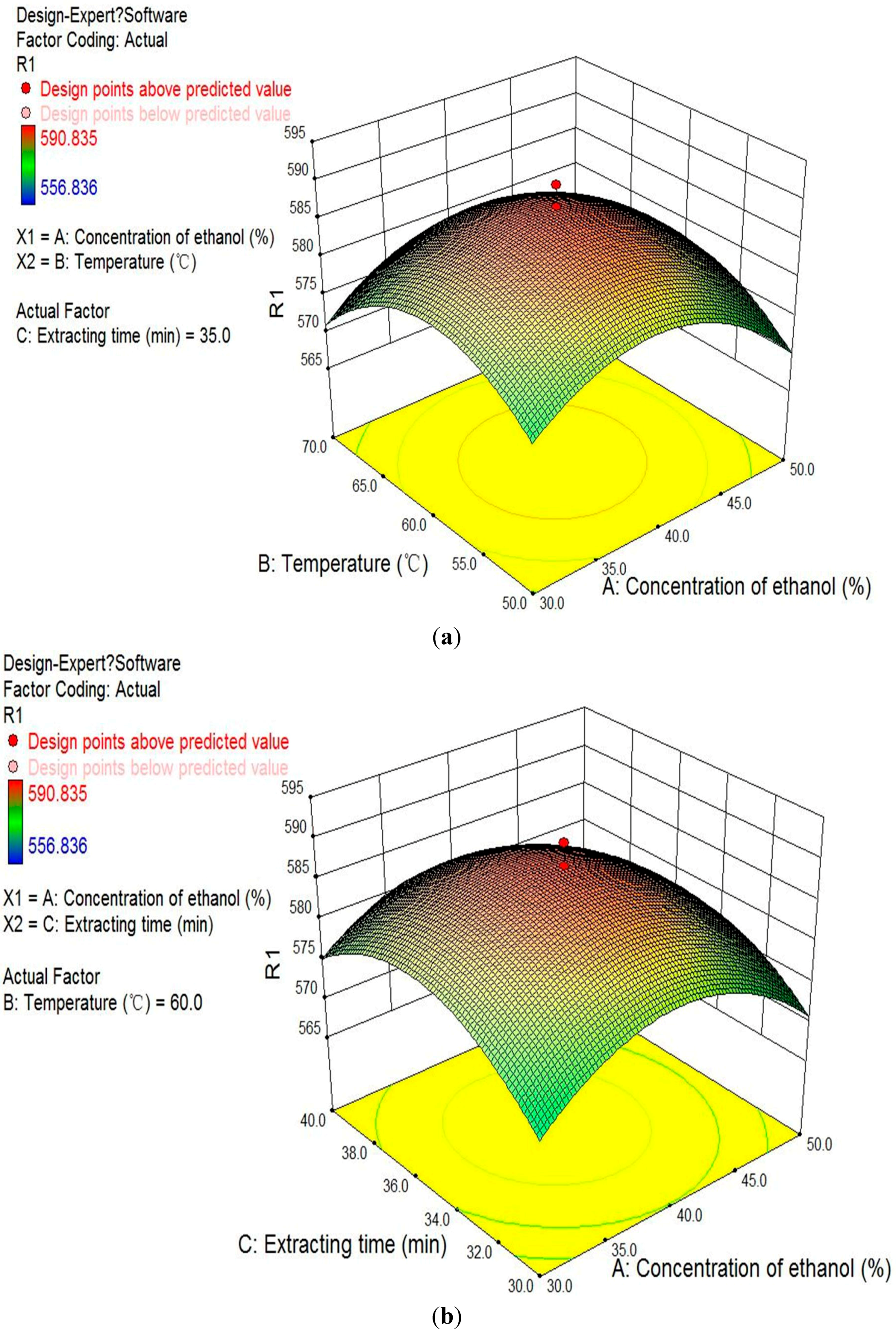Optimization of Ultrasound-Assisted Extraction of Natural Antioxidants from the Osmanthus fragrans Flower
Abstract
:1. Introduction
2. Results and Discussion
2.1. The Results from Single Factor Experiment

2.2. The Results from Response Surface Methodology
| Independent Variable | Units | Symbol | Coded Levels | ||||
|---|---|---|---|---|---|---|---|
| −1.68 | −1 | 0 | 1 | 1.68 | |||
| Concentration of ethanol | % (v/v) | X1 | 23.2 | 30 | 40 | 50 | 56.8 |
| Temperature | °C | X2 | 43.2 | 50 | 60 | 70 | 76.8 |
| Extracting time | min | X3 | 26.6 | 30 | 35 | 40 | 43.4 |
| Standard Order a | Run Order b | X1 | X2 | X3 | Response Y |
|---|---|---|---|---|---|
| Concentration of Ethanol (%) | Temperature (°C) | Extracting Time (min) | TEAC Values (μmol Trolox/g) | ||
| 1 | 1 | 30.0 | 50.0 | 30.0 | 569.2 |
| 2 | 5 | 50.0 | 50.0 | 30.0 | 566.7 |
| 3 | 10 | 30.0 | 70.0 | 30.0 | 556.8 |
| 4 | 13 | 50.0 | 70.0 | 30.0 | 560.8 |
| 5 | 4 | 30.0 | 50.0 | 40.0 | 565.2 |
| 6 | 15 | 50.0 | 50.0 | 40.0 | 562.3 |
| 7 | 9 | 30.0 | 70.0 | 40.0 | 567.7 |
| 8 | 6 | 50.0 | 70.0 | 40.0 | 564.2 |
| 9 | 8 | 23.2 | 60.0 | 35.0 | 568.2 |
| 10 | 14 | 56.8 | 60.0 | 35.0 | 559.1 |
| 11 | 18 | 40.0 | 43.2 | 35.0 | 565.2 |
| 12 | 17 | 40.0 | 76.8 | 35.0 | 564.7 |
| 13 | 2 | 40.0 | 60.0 | 26.6 | 565.7 |
| 14 | 3 | 40.0 | 60.0 | 43.4 | 568.2 |
| 15 | 19 | 40.0 | 60.0 | 35.0 | 587.9 |
| 16 | 16 | 40.0 | 60.0 | 35.0 | 590.8 |
| 17 | 12 | 40.0 | 60.0 | 35.0 | 587.9 |
| 18 | 20 | 40.0 | 60.0 | 35.0 | 586.4 |
| 19 | 7 | 40.0 | 60.0 | 35.0 | 586.4 |
| 20 | 11 | 40.0 | 60.0 | 35.0 | 587.9 |
| Term | Sum of Squares | Degrees of Freedom | Mean Square | F Value | p Value |
|---|---|---|---|---|---|
| Model | 2427.7 | 9 | 269.7 | 64.0 | <0.0001 b |
| Concentration of ethanol, X1 | 30.1 | 1 | 30.1 | 7.1 | 0.0235 a |
| Temperature, X2 | 15.7 | 1 | 15.7 | 3.7 | 0.0828 a |
| Extracting time, X3 | 7.4 | 1 | 7.4 | 1.8 | 0.2145 |
| X1X2 | 4.4 | 1 | 4.4 | 1.0 | 0.3326 |
| X1X3 | 7.8 | 1 | 7.8 | 1.8 | 0.2044 |
| X2X3 | 64.2 | 1 | 64.2 | 15.2 | 0.0029 b |
| X12 | 1044.7 | 1 | 1044.7 | 247.9 | <0.0001 b |
| X22 | 930.5 | 1 | 930.5 | 220.8 | <0.0001 b |
| X32 | 776.1 | 1 | 776.1 | 184.1 | <0.0001 b |
| Residual | 42.2 | 10 | 4.2 | ||
| Lack of Fit | 29.0 | 5 | 5.8 | 2.2 | 0.2016 |
| Pure Error | 13.1 | 5 | 2.6 | ||
| Cor Total | 2469.9 | 19 | |||
| R2 | 0.9829 | ||||
| Adj. R2 | 0.9676 |


2.3. Comparison of Ultrasound-Assisted Extraction with Other Methods
3. Experimental Section
3.1. Chemicals
3.2. Instruments
3.3. Sample Treatment
3.4. Trolox Equivalent Antioxidant Capacity (TEAC) Assay
3.5. Experimental Design
3.6. Other Extracting Methods for Comparison
3.7. Statistical Analysis
4. Conclusions
Acknowledgments
Author Contributions
Conflicts of Interest
References
- Aruoma, O.I. Free radicals, oxidative stress, and antioxidants in human health and disease. J. Am. Oil Chem. Soc. 1998, 75, 199–212. [Google Scholar] [CrossRef]
- Hu, F.B. Plant-based foods and prevention of cardiovascular disease: An overview. Am. J. Clin. Nutr. 2003, 78, 544–551. [Google Scholar]
- Riboli, E.; Norat, T. Epidemiologic evidence of the protective effect of fruit and vegetables on cancer risk. Am. J. Clin. Nutr. 2003, 78, 559–569. [Google Scholar]
- Block, G.; Patterson, B.; Subar, A. Fruit, vegetables, and cancer prevention: A review of the epidemiological evidence. Nutr. Cancer 1992, 18, 1–29. [Google Scholar] [CrossRef] [PubMed]
- Duthie, G.G.; Duthie, S.J.; Kyle, J.A.M. Plant polyphenols in cancer and heart disease: Implications as nutritional antioxidants. Nutr. Res. Rev. 2000, 13, 79–106. [Google Scholar] [CrossRef] [PubMed]
- Fu, L.; Xu, B.T.; Xu, X.R.; Gan, R.Y.; Zhang, Y.; Xia, E.Q.; Li, H.B. Antioxidant capacities and total phenolic contents of 62 fruits. Food Chem. 2011, 129, 345–350. [Google Scholar] [CrossRef]
- Leifert, W.R.; Abeywardena, M.Y. Cardioprotective actions of grape polyphenols. Nutr. Res. 2008, 28, 729–737. [Google Scholar] [CrossRef] [PubMed]
- Bartosz, G. Oxidative stress in plants. Acta Physiol. Plant. 1997, 19, 47–64. [Google Scholar] [CrossRef]
- Leja, M.; Mareczek, A.; Ben, J. Antioxidant properties of two apple cultivars during long-term storage. Food Chem. 2003, 80, 303–307. [Google Scholar] [CrossRef]
- Deng, G.F.; Xu, X.R.; Guo, Y.J.; Xia, E.Q.; Li, S.; Wu, S.; Chen, F.; Ling, W.H.; Li, H.B. Determination of antioxidant property and their lipophilic and hydrophilic phenolic contents in cereal grains. J. Funct. Food. 2012, 4, 906–914. [Google Scholar] [CrossRef]
- Li, H.B.; Cheng, K.W.; Wong, C.C.; Fan, K.W.; Chen, F.; Jiang, Y. Evaluation of antioxidant capacity and total phenolic content of different fractions of selected microalgae. Food Chem. 2007, 102, 771–776. [Google Scholar] [CrossRef]
- Li, S.; Li, S.K.; Gan, R.Y.; Song, F.L.; Kuang, L.; Li, H.B. Antioxidant capacities and total phenolic contents of infusions from 223 medicinal plants. Ind. Crop. Prod. 2013, 51, 289–298. [Google Scholar] [CrossRef]
- Onanong, K.; Sirithon, S.; Natthida, W.; Naret, M. Phenolic compounds and antioxidant activities of edible flowers from Thailand. J. Funct. Food. 2011, 2, 88–99. [Google Scholar]
- Li, A.N.; Li, S.; Li., H.B.; Xu, D.P.; Xu, X.R.; Chen, F. Total phenolic contents and antioxidant capacities of 51 edible and wild flowers. J. Funct. Food. 2014, 6, 319–330. [Google Scholar] [CrossRef]
- Hung, C.Y.; Tsai, Y.C.; Li, K.Y. Phenolic antioxidants isolated from the flowers of Osmanthus fragrans. Molecules 2012, 17, 10724–10737. [Google Scholar] [CrossRef] [PubMed]
- Wang, H.S.; Pan, Y.M.; Tang, X.J.; Huang, Z.Q. Isolation and characterization of melanin from Osmanthus fragrans seeds. LWT Food Sci. Technol. 2006, 39, 496–502. [Google Scholar] [CrossRef]
- Karabegovic, I.T.; Veljkovic, V.B.; Lazic, M.L. Ultrasound-assisted extraction of total phenols and flavonoids from dry tobacco (Nicotiana tabacum) leaves. Nat. Prod. Commun. 2011, 6, 1855–1856. [Google Scholar] [PubMed]
- Ricardez, O.F.M.; Ruiz-Jimenez, J.; Lagunez-Rivera, L.; Luque de Castro, M.D. Fast ultrasound-assisted extraction of polar (phenols) and nonpolar (lipids) fractions in Heterotheca inuloides Cass. Phytochem. Anal. 2011, 22, 484–491. [Google Scholar] [CrossRef] [PubMed]
- Horzic, D.; Belscak-Cvitanovic, A.; Komes, D.; Lelas, V. Comparison of conventional and ultrasound assisted extraction techniques of yellow tea and bioactive composition of obtained extracts. Food Bioprocess. Technol. 2012, 5, 2858–2870. [Google Scholar] [CrossRef]
- Xia, E.Q.; Yu, Y.Y.; Xu, X.R.; Deng, G.F.; Guo, Y.J.; Li, H.B. Ultrasound-assisted extraction of oleanolic acid and ursolic acid from Ligustrum lucidum Ait. Ultrason. Sonochem. 2012, 19, 772–776. [Google Scholar] [CrossRef] [PubMed]
- Haaland, P.O. Experimental Design in Biotechnology; Marcel Dekker: New York, NY, USA, 1989. [Google Scholar]
- Box, G.E.P.; Wilson, K.B. On the experimental attainment of optimum conditions. J. R. Stat. Soc. B. 1951, 13, 1–45. [Google Scholar]
- Liyana-Pathirana, C.; Shahidi, F. Optimization of extraction of phenolic compounds from wheat using response surface methodology. Food Chem. 2005, 93, 47–56. [Google Scholar] [CrossRef]
- Myers, R.H.; Montgomery, D.C. Response Surface Methodology: Process and Product Optimization Using Designed Experiments, 2nd ed.; Wiley: New York, NY, USA, 2002. [Google Scholar]
- Stroescu, M.; Stoica-Guzun, A.; Ghergu, S.; Chira, N.; Jipa, I. Optimization of fatty acids extraction from Portulaca oleracea seed using response surface methodology. Ind. Crop. Prod. 2013, 43, 405–411. [Google Scholar] [CrossRef]
- Xia, E.Q.; Ai, X.X.; Zang, S.Y.; Xu, X.R.; Li, H.B. Ultrasound-assisted extraction of phillyrin from Forsythia suspense. Ultrason. Sonochem. 2011, 18, 549–552. [Google Scholar] [CrossRef] [PubMed]
- Xu, Y.; Pan, S.Y. Effects of various factors of ultrasonic treatment on the extraction yield of all-trans-lycopene from red grapefruit (Citrus paradise Macf.). Ultrason. Sonochem. 2013, 20, 1026–1032. [Google Scholar] [CrossRef] [PubMed]
- Ying, Z.; Han, X.X.; Li, J.R. Ultrasound-assisted extraction of polysaccharides from mulberry leaves. Food Chem. 2011, 127, 1273–1279. [Google Scholar] [CrossRef] [PubMed]
- Dong, J.; Liu, Y.; Liang, Z.; Wang, W. Investigation on ultrasound-assisted extraction of salvianolic acid B from Salvia miltiorrhiza root. Ultrason. Sonochem. 2010, 17, 61–65. [Google Scholar] [CrossRef] [PubMed]
- Kim, S.J.; Murthy, H.N.; Hahn, E.J.; Lee, H.L.; Paek, K.Y. Parameters affecting the extraction of ginsenosides from the adventitious roots of ginseng (Panax ginseng C.A. Meyer). Sep. Purif. Technol. 2007, 56, 401–406. [Google Scholar] [CrossRef]
- Wang, L.; Weller, C.L. Recent advances in extraction of nutraceuticals from plants. Trends Food Sci. Technol. 2006, 17, 300–312. [Google Scholar] [CrossRef]
- Xi, J.; Wang, B.S. Optimization of ultrahigh-pressure extraction of polyphenolic antioxidants from green tea by response surface methodology. Food Bioprocess. Technol. 2013, 6, 2538–2546. [Google Scholar] [CrossRef]
- Henning, S.M.; Niu, Y.T.; Lee, N.H.; Thames, G.D.; Minutti, R.R.; Wang, H.J.; Go, V.L.W.; Heber, D. Bioavailability and antioxidant activity of tea flavanols after consumption of green tea, black tea, or a green tea extract supplement. Am. J. Clin. Nutr. 2004, 80, 1558–1564. [Google Scholar] [PubMed]
- Deng, G.F.; Xu, D.P.; Li, S.; Li, H.B. Optimization of ultrasound-assisted extraction of natural antioxidants from sugar apple (Annona squamosa L.) peel using response surface methodology. Molecules 2015, 20, 20448–20459. [Google Scholar] [CrossRef] [PubMed]
- Xu, D.P.; Zhou, Y.; Zheng, J.; Li, S.; Li, A.N.; Li, H.B. Optimization of ultrasound-assisted extraction of natural antioxidants from the flower of Jatropha integerrima by response surface methodology. Molecules 2016, 21, 18. [Google Scholar] [CrossRef] [PubMed]
- Li, S.; Deng, G.F.; Li, A.N.; Xu, X.R.; Wu, S.; Li, H.B. Effect of ultrasound-assisted extraction on antioxidant activity of rose (Rosa hybrida) petals. Int. J. Mod. Biol. Med. 2012, 2, 91–100. [Google Scholar]
- Re, R.; Pellegrini, N.; Proteggente, A.; Pannala, A.; Yang, M.; Rice-Evans, C. Antioxidant activity applying an improved ABTS radical cation decolo rization assay. Free Radic. Biol. Med. 1999, 26, 1231–1237. [Google Scholar] [CrossRef]
- Araujo, G.S.; Matos, L.J.B.L.; Fernandes, J.O.; Cartaxo, S.J.M.; Goncalves, L.R.B.; Fernandes, F.A.N.; Farias, W.R.L. Extraction of lipids from microalgae by ultrasound application: Prospection of the optimal extraction method. Ultrason. Sonochem. 2013, 20, 95–98. [Google Scholar] [CrossRef] [PubMed]
- Sample Availability: Samples of the compounds are not available from the authors.
© 2016 by the authors. Licensee MDPI, Basel, Switzerland. This article is an open access article distributed under the terms and conditions of the Creative Commons by Attribution (CC-BY) license ( http://creativecommons.org/licenses/by/4.0/).
Share and Cite
Li, A.-N.; Li, S.; Li, Y.; Xu, D.-P.; Li, H.-B. Optimization of Ultrasound-Assisted Extraction of Natural Antioxidants from the Osmanthus fragrans Flower. Molecules 2016, 21, 218. https://doi.org/10.3390/molecules21020218
Li A-N, Li S, Li Y, Xu D-P, Li H-B. Optimization of Ultrasound-Assisted Extraction of Natural Antioxidants from the Osmanthus fragrans Flower. Molecules. 2016; 21(2):218. https://doi.org/10.3390/molecules21020218
Chicago/Turabian StyleLi, An-Na, Sha Li, Ya Li, Dong-Ping Xu, and Hua-Bin Li. 2016. "Optimization of Ultrasound-Assisted Extraction of Natural Antioxidants from the Osmanthus fragrans Flower" Molecules 21, no. 2: 218. https://doi.org/10.3390/molecules21020218






